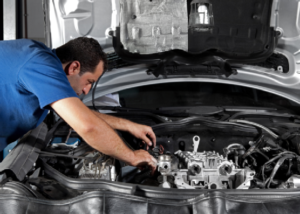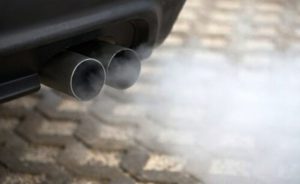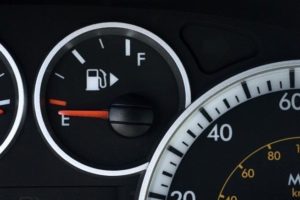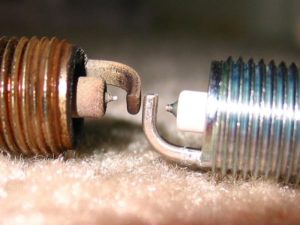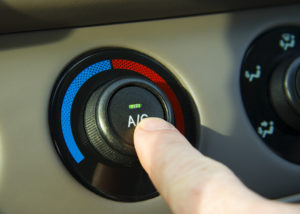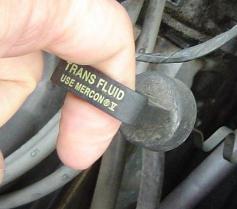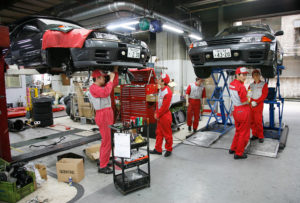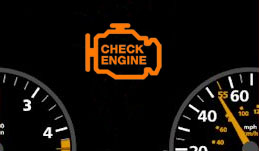
What are the most common trouble codes that can cause your Check Engine light to come on? The following is the list of the 20 most common OBD II trouble codes with vehicles tested in 2009:
P0420 – Catalyst System Low Efficiency – 13.2%
P0171 – Fuel Trim System Lean Bank 1 – 10.4%
P0401 – Exhaust Gas Recirculation (EGR) Flow Insufficient – 8.4%
P0174 – Fuel Trim System Lean Bank 2 – 6.8%
P0442 – Evaporative Emission (EVAP) System Small Leak Detected – 6.7%
P0300 – Engine Misfire Detected (random misfire) – 6.4%
P0455 – Evaporative Emission (EVAP) System Leak Detected (large) – 6.2%
P0440 – Evaporative Emission (EVAP) System – 5.5%
P0141 – Oxygen Sensor Heater (H02S) Performance Bank 1 Sensor 2 – 5.1%
P0430 – Catalyst System Low Efficiency Bank 2 – 3.2%
P0135 – Oxygen Sensor (HO2S) Performance Bank 1 Sensor 1 – 3.2%
P0446 – EVAP Vent Solenoid Valve Control System – 3.1%
P0128– Coolant Thermostat – 3.1%
P0301 – Cylinder 1 Misfire Detected – 3.1%
P0411 – EVAP System Control Incorrect Purge Flow – 2.8%
P0133 – Oxygen Sensor Slow Response Bank 1 Sensor 1 – 2.8%
P0303 – Cylinder 3 Misfire Detected – 2.6%
P0304 – Cylinder 4 Misfire Detected – 2.6%
P0302 – Cylinder 2 Misfire Detected – 2.6%
P0325 – PCM Knock Sensor Circuit – 2.1%
Based on the above data, it would seem likely that the number one most common reason for the Check Engine light coming on would be a worn out or fouled catalytic converter. But when you combine all of the related codes by system or component, you get a somewhat different picture. Looking at the data this way, these are the systems that are most likely to cause an emissions failure:
Evaporative Emission System – 24.3%
Engine Misfire – 17.3%
Fuel Trim (lean) – 17.2%
Catalytic converter – 16.4%
Oxygen sensor related – 11.1% Exhaust Gas Recirculation (EGR) system – 8.4%
Causes of Common Trouble Codes
To pass an OBD II plug-in emissions test, all of the OBD system monitors (self-tests) must have run and completed, and there must be no trouble codes found. So if your vehicle has one or more trouble codes, simply erasing the codes with a scan tool won’t fix your problem. The cause of the trouble codes has to be diagnosed and repaired. The vehicle must then be driven until all of the OBD monitors complete their self-tests (which can be verified with a scan tool), and there must be no new codes. Then and only then will the vehicle pass the OBD II plug-in emissions test.
Causes of Evaporative Emission System Related Codes P0411 P0440 P0442 P0446P0455
The Evaporative Emission Control system prevents fuel vapors from escaping from the fuel tank. The EVAP system includes vent hoses and a charcoal canister for capturing and storing fuel vapors, and a purge valve for siphoning the fumes into the engine when it is running. It also has a pressure or vacuum sensor for detecting small and large vapor leaks. The most common cause of a P0455 EVAP Leak Code is a loose or missing gas cap. A small leak code (P0442) may indicate a cracked or loose fuel tank vapor hose, a leaky EVAP storage canister, or a fault in the purge valve or EVAP leak detection system. You can check the gas cap yourself to make sure it fits tightly. But these other problems can be very difficult to diagnose and usually require professional help. Technicians can use a special “smoke” machine that lightly pressurizes the EVAP system and fuel tank to find leaks. The machine heats mineral oil to create a vapor-like smoke, which may also contain UV leak detection dye that makes small leaks easier to find. A professional level scan tool with bidirectional communication ability is also necessary to cycle the purge solenoid and run other EVAP self-tests.
Causes of Engine Misfire Trouble Codes P0300 P0301 P0302 P0303 P0304 P0305
Misfire codes don’t tell you why your engine is misfiring, only that one or more cylinders are not running properly. The OBD II system tracks misfires by detecting subtle changes in the speed of the crankshaft via the crankshaft position sensor while the engine is running. A misfire causes a slight loss of speed in the rotating crankshaft, which the OBD II system logs as a misfire. A few misfires are normal, but if the engine experiences an excessive number of misfires within a given period of time, it will set one or more misfire codes. The last digit in the code indicates the number of the cylinder that is misfiring. A P0300 code means the engine has a random misfire that jumps around from cylinder to cylinder.
P0300 random misfire codes are caused by vacuum leaks (loose or cracked vacuum hoses, leaky intake manifold gaskets, or a leaky vacuum brake booster), as well as a lean fuel mixture. A lean mixture, which may also set a P0171 or P0174 code, means your engine is not getting enough fuel, or is getting too much air, possibly through a vacuum leak or a leaky EGR valve. Dirty fuel injectors or low fuel pressure can be factors that may cause a P0300 random misfire code to set. Bad gas that contains too much alcohol or water may also cause this type of code to set.
Cylinder specific misfire codes (such as P0301, P0302, etc.) tell you that a specific cylinder is misfiring, but the code does not tell you why. The cause might be ignition-related (worn or fouled spark plug, bad plug wire or coil-on-plug ignition coil), fuel-related (dead or dirty fuel injector), or compression-related (bent or burned valve or leaky head gasket).
All of these possibilities must be investigated to rule out the cause of the misfire.
Causes of Fuel Trim Trouble Codes P0171 P0174
A P0171 or P0174 trouble code tells you the fuel mixture is running lean (not enough fuel and/or too much air). This type of problem can be confirmed by looking at the Short Term Fuel Trim (STFT) and Long Term Fuel Trim (LTFT) values with a scan tool. Normally, STFT and LTFT should be plus or minus 5 to 10 from zero. If STFT and/or LTFT are more than about +12, it indicates the engine is running lean. Negative numbers (-12 or more) indicates the engine is running rich.
A lean fuel condition can be caused by:
* Low fuel pressure due to a weak pump or leaky fuel pressure regulator. Use a fuel pressure gauge to check fuel pressure at idle. If fuel pressure is less than specifications, your fuel filter may be plugged, your fuel pump may be failing or have a bad wiring connection, or the fuel pressure regulator may be leaking.
*Dirty fuel injectors. Cleaning the injectors with a fuel system additive, or having the injectors professionally cleaned may solve your problem.
* Vacuum leaks at the intake manifold, vacuum hose connections or throttle body.
* Leaky EGR valve. Check the operation of EGR valve and system, and for a buildup of carbon under the valve.
* Leaky PCV Valve or hose. (Check valve and hose connections)
* Dirty or defective Mass Airflow Sensor (MAF). Try cleaning the MAF sensor wires or filament with aerosol electronics cleaner. Do NOT use anything else to clean the sensor, and do not touch the sensor wires.
Causes of Catalytic Converter Codes P0420 P0430
On OBD II vehicles, there is a “downstream” oxygen sensor to monitor the efficiency of the catayltic converter. If the converter has become contaminated because the engine is burning oil or leaking coolant internally, or it is worn out from age, it won’t function as it should causing an increase in tailpipe emissions. The downstream oxygen sensor monitors the activity of the converter, and the engine computer compares the readings of the upstream and downstream oxygen sensors to determine how efficiently the converter is working. If efficiency drops below a certain point, it sets a P0420 or P0430 code.
Nine times out of ten, either code usually means the converter has reached the end of the road and needs to be replaced. There is no way to rejuvenate a failing converter, so replacing it is your only repair option. Removing it altogether is NOT an option as this is considered to be emissions tampering. A missing converter will cause your vehicle to fail the emissions test.
Causes of Oxygen Sensor Trouble Codes P0133 P0135 P0141
Oxygen sensors monitor the amount of oxygen in the exhaust so the engine computer (PCM) can adjust the fuel mixture to minimize emissions and maximize fuel economy. There are two types of oxygen sensor trouble codes: O2 heater circuit codes and O2 sensor codes. A heater codes will set if a fault is detected in the circuit that warms up the oxygen sensor when your engine is first started. This is necessary to reduce cold start emissions. An O2 sensor performance code will be set if the O2 sensor readings remain low (lean), or high (rich), or do not change quickly enough, or do not change at all.
A low voltage (lean) oxygen sensor reading may indicate the sensor has failed, or that it is being “fooled” by an exhaust manifold vacuum leak, or a condition that allows unburned oxygen to enter the exhaust such as a burned or bend exhaust valve, or a misfiring spark plug.
NOTE: If you get an oxygen sensor code plus a random misfire code and/or a MAP sensor code, the engine probably has a serious vacuum leak.
Causes of EGR Trouble Codes P0401
The Exhaust Gas Recirculation (EGR) system uses a vacuum actuated or electronic valve between the intake and exhaust manifolds to recirculates a small amount of exhaust back into the intake manifold. This occurs when the engine is at normal temperature and is accelerating or running under a heavy load. The exhaust gas dilutes the air/fuel mixture slightly to reduce combustion temperatures. This does two things; it reduces the formation of oxides or nitrogen (NOX) in the combustion chamber, and it helps the engine resist detonation (spark knock). If the EGR valve fails, or it is not flowing properly due to an accumulation of carbon under the valve, it can set an EGR trouble code. The fix is to observe and test the operation of the EGR valve and system, and to clean or remove any carbon deposits under the valve or in the intake manifold EGR passages. On Ford vehicles, EGR codes are often caused by a defective DPFE sensor in the EGR system.
Causes of Coolant Thermostat Trouble Codes P0128
The thermostat speeds engine warm up after a cold start, and regulates the engine’s operating temperature when it is running. If the thermostat sticks shut, it can cause the engine to overheat. If the thermostat fails to close, the engine may never achieve normal operating temperature. This will prevent it from going into closed loop feedback control of the fuel mixture (which makes the engine run rich and waste fuel). This code is set of conditions indicate the thermostat is not working properly.
Causes of Knock Sensor Trouble Codes P0325
The knock sensor generates a signal when it detects engine vibrations that are typically produced by detonation (spark knock) during hard acceleration or when lugging the engine. The PCM uses this information to retard spark timing slightly until the detonation stops. The P0325 code may be set if the PCM gets a steady knock signal from the knock sensor. The problem may be a faulty sensor or it may be operating conditions that are causing prolonged detonation. The vibrations that may occur when driving on an unusually rough road may set a false knock sensor code. Other conditions that may contribute to spark knock include engine overheating, low octane fuel, a buildup of carbon in the combustion chambers which raises compression or loss of EGR.
SOURCE: aa1car


